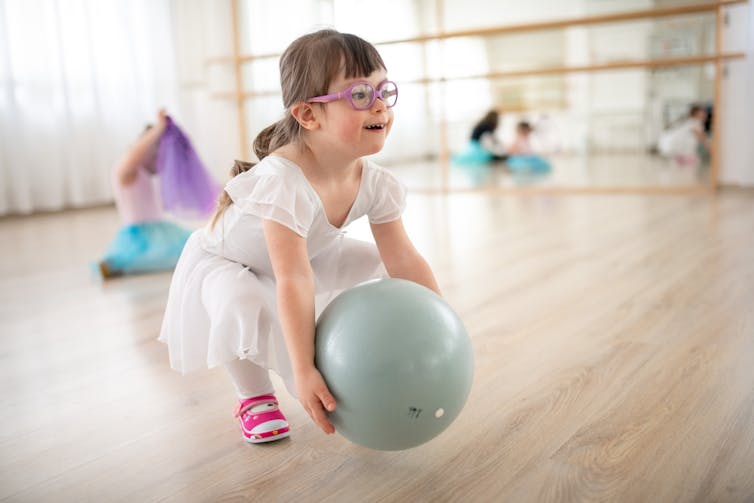
Physical activity is important for children; it supports improved health, development and sleep. However, children in the early years (from birth to age five) with disabilities are consistently underrepresented in national monitoring, and are subsequently excluded from intervention efforts promoting physical activity.
The ParticipACTION Report Card on Physical Activity for Children and Youth (the most comprehensive assessment of child and youth physical activity in Canada) was released in May, and again reported a noticeable lack of available data for children with disabilities. As researchers in the Child Health and Physical Activity Lab in the School of Occupational Therapy at Western University, we focus on promoting physical activity for all young children.
New research conducted in our lab shows that young children with disabilities have markedly low levels of physical activity. These children are missing out on the numerous benefits of engaging in physical activity.

(Shutterstock)
Physical inactivity costs Canadian taxpayers an estimated $6.8 billion per year and is associated with a range of non-communicable diseases. Physical activity levels in early childhood have been shown to track throughout life, making participation in these behaviours at an early age critical to establishing lifelong healthy habits.
It is estimated that 78 percent of young children without a diagnosed disability meet current international physical activity guidelines from the World Health Organization, meaning they spend 12.5 percent of their day engaged in physical activity. However, children with some types of disability spend as little as 0.3 percent of their day engaged in physical activity.
Why children with disabilities are underrepresented
Given the physical, social and economic prioritization of physical activity in our society, why are monitoring and reporting of physical activity in young children with disabilities being missed?

(Shutterstock)
Below we offer five plausible reasons for the lack of representation based on a recent systematic review conducted in our lab:
1. Research gaps: There is a scarcity of high-quality evidence addressing physical activity in children with disabilities. The review conducted by our lab found only 21 studies internationally that examined physical activity levels of young children with disabilities. Of the research conducted, there were generally small numbers of children included in the studies, making it incredibly challenging to obtain an accurate depiction of the context of physical activity among young children with disabilities.
2. Measurement: The first step in being able to determine the physical activity levels of young children is ensuring accurate and feasible measurement tools. At present, the measurement literature primarily focuses on young children without disabilities. It’s also largely unknown whether the tools researchers typically rely on are appropriate methods to measure physical activity among children with disabilities. The accuracy and appropriateness of measurement tools may vary depending on the type of disability. Uncertainty of the appropriateness of measurement tools may be contributing towards a lack of physical activity monitoring among this group of children.
3. Classifying disability: The amount and intensity of physical activity that young children engage in can vary widely, within and between disability types. Research on physical activity of young children with disabilities often relies on assessment of certain disabilities such as attention-deficit hyperactivity disorder, autism spectrum disorder or cerebral palsy, precluding knowledge on physical activity for children with other disabilities. Additionally, the difficulty recruiting participants often means a lack of representation of many disability types in physical activity research.
4. Age of diagnosis: As medical and societal understandings of disability change over time, diagnoses are being made earlier in life. Research, on the other hand, is not keeping up. We found a lack of studies exploring the ways children with disabilities engage in physical activity in the early years, with most research being conducted when children enter the school-aged years (ages 5 to 17 years). Longitudinal research beginning in early childhood, such as in childcare and family homes, is needed to explore how children with disabilities engage in physical activity.
5. Reconceptualizing definitions: Physical activity types and intensities occur in varied ways for young children with disabilities, in part dependent on diverse abilities. This creates a need to reconsider current definitions and incorporate the diverse ways children living with disabilities engage in and experience physical activity, which may not align with current understandings, definitions and measurements of physical activity. We need to understand what physical activity looks like for these children to fully appreciate and acknowledge physical activity achievements.
5 key areas for better representation of children with disabilities

(Shutterstock)
We propose addressing five key areas to move towards better representation of young children with disabilities in activity monitoring:
1) High-quality research, with larger sample sizes where possible;
2) Investigation into accurate and appropriate measurement tools for assessing physical activity;
3) Research with young children with a range of disability types;
4) More research from early life, to ensure young children are supported in appropriate physical activity from infancy;
5) Reconceptualizing definitions of physical activity, including what physical activity may encompass for young children with disabilities, moving away from a one-size-fits-all definition that we tend to use in public health discourse.
Continued advocacy for all young children is needed to ensure they grow up in an inclusive society with equal opportunity to obtain the benefits of physical activity.
Better research representation is the first step in ensuring that young children with disabilities are accounted for in national physical activity monitoring and reporting. This will create the space for inclusion of these young children in physical activity intervention efforts and opportunities for young children with disabilities to be more physically active.
![]()
Sophie M Phillips receives funding from Children’s Health Research Institute and Mitacs.
Leah Taylor receives funding from CIHR.
Trish Tucker has received funding from CIHR, SSHRC, CFI, the Lawson Foundation, Children’s Health Research Institute and Western University. She is a Scientist at the Children’s Health Research Institute.























